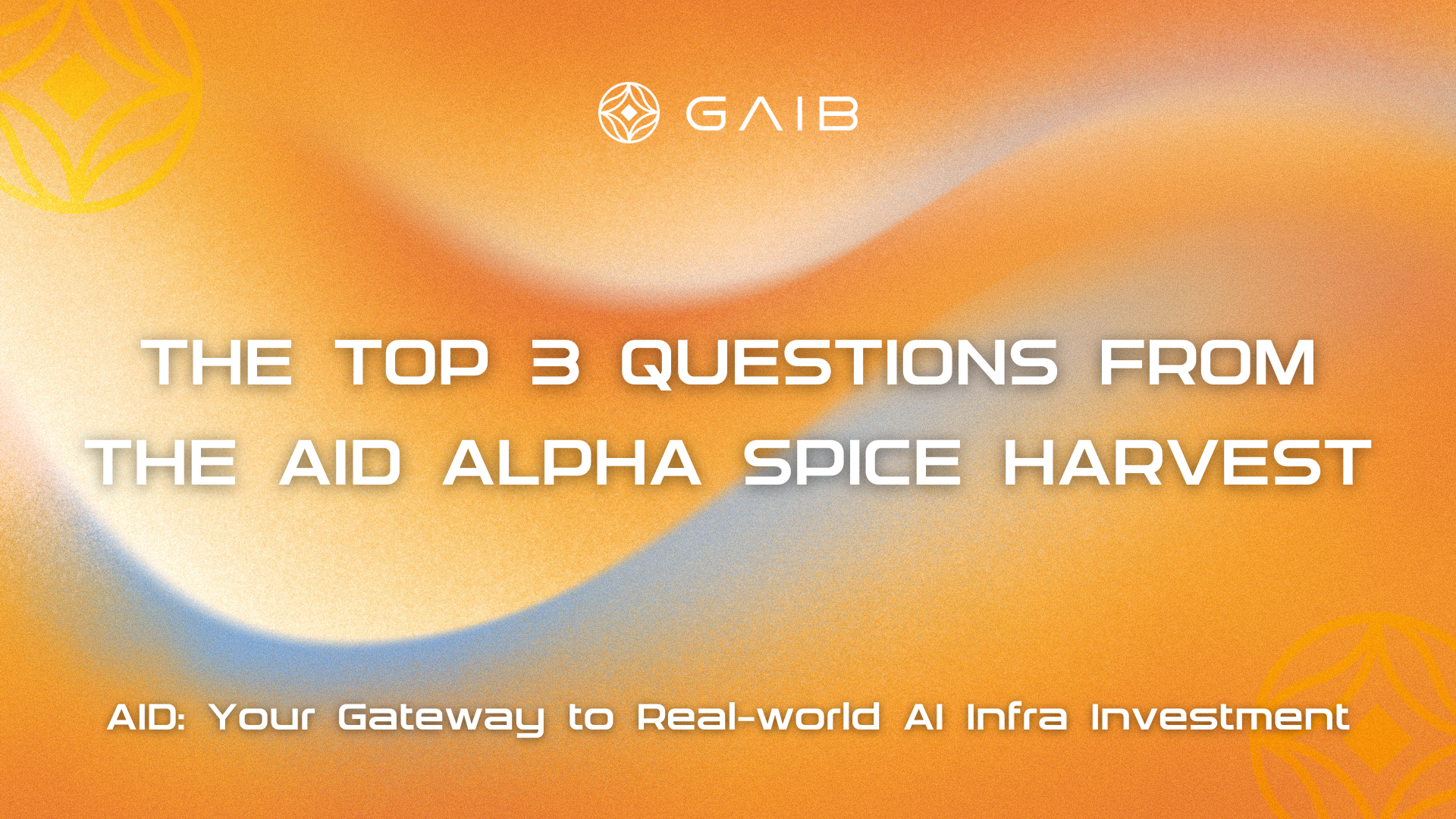The Top 3 Questions from the AID Alpha Spice Harvest

As of August 17th, AID Alpha: The Spice Harvest has successfully reached $50 million in TVL target, with more than 70k wallet addresses participating in this AID pre-deposit campaign — highlighting the true demand for real-world AI yields from both individual and institutional investors.
Notably, on July 30th, Amber Group (Nasdaq: AMBR) — a leading global digital asset management platform announced to allocate $10 million to AID Alpha as a strategic investment to accelerate building onchain AI infra economy.
This article walks through three key questions we’ve received during this campaign to help current and prospective investors better understand GAIB and our product
- Where do AID yields come from?
- How does GAIB manage offchain risk?
- What makes AID different from other AI investments?
About AID
AID (AI Dollar) is a synthetic dollar and the first product launched by GAIB. Each AID token is backed by a diversified portfolio of enterprise-grade GPU financing deals, along with a reserve of U.S. Treasury bills.
In practice, GAIB allocates majority of capital to real-world, offchain AI infra financing deals, such as cloud service providers (CSPs) and AI data centers. These deals enable cloud operators to scale their GPU capacity to meet surging demand for AI workloads and secure long-term customer contracts.
In return, onchain users gain access to the yield generated from these financing deals. The remaining funds are allocated to the U.S. Treasury bills (T-bills), chosen for their high liquidity and stable returns. This reserve ensures sufficient redemption liquidity for AID holders.
Where do AID’s yields come from?
To address the limitations of traditional capital solutions for CSPs and data centers, GAIB offers more efficient and flexible financing structures tailored to the diversified capital needs of AI infra operators. These structures fall into three categories:
1) Debt Model: GAIB acts as a lender, providing capital to data centers with a fixed repayment schedule and interest rate. This model mirrors a typical private credit arrangement (direct lending from non-bank institutions to corporates), where borrowers are contractually obligated to repay the principal and interest over time. (Estimated 10–20% APY)
2) Equity Model: Instead of fixed repayments, GAIB invests in the form of equity or revenue-sharing agreements. In this structure, data centers share a portion of their future GPU-related revenues with GAIB (Estimated 60–80% APY)
3) Hybrid Model: This structure combines elements of both debt and equity, offering greater flexibility. Terms can be customized based on the data center’s growth stage, capital needs, and expected cash flows.
In addition to the yields generated from GPU financing deals, AID also captures returns from U.S. T-bills, as a portion of the underlying capital is allocated to these low-risk assets, contributing an additional layer of stable income for AID holders.
When the official AID tokens go live, users will be able to stake their AID to receive sAID (staked version of AID) — a yield-bearing token. Staking rewards are reflected in the appreciation of the sAID-to-AID exchange rate over time, as protocol-level revenues flow in. These revenues are derived from a blended return of GPU financing deals and T-bills.
For example, the initial exchange rate between AID and sAID is at 1 : 1 when User A stakes AID. After 6 months, as the protocol revenues flow in, the exchange rate may rise to 1.25 : 1. In this case, User A would receive 1.25 AID when unstake 1 sAID, the additional 0.25 AID representing the staking rewards.
How Does GAIB Manage OffChain Risk?
As GAIB allocates onchain capital into offchain AI infra investment, one of the most frequently asked questions is: How are users’ funds protected when deployed into real-world financing deals?
Firstly, capital safety is our top priority. To address offchain risk and safeguard investor funds, we implement a comprehensive multi-layered risk management framework, it includes:
1) Rigorous Due Diligence (DD)
Before structuring any financing deal, GAIB or trusted 3rd underwriters team conducts thorough DD on the prospective data center. This includes evaluating its financial sheets , existing GPU capacity, customer contracts, payment history, and overall creditworthiness. Where appropriate, third-party auditors are brought in to validate key operational and financial data. The goal is to ensure the borrower/investment receivers has the capacity and reliability to meet its repayment obligations.
2) SPV-Based Deal Structure (Bankruptcy-Remote)
To legally separate the collateralized GPU assets from the data center’s core operations, each financing deal is structured through a dedicated Special Purpose Vehicle (SPV). This “bankruptcy-remote” structure ensures that even in the event of default at the parent company, the assets held by the SPV remain secure and recoverable by GAIB.
3) Over-Collateralization
Data centers are required to transfer GPU assets into the SPV, which serve as primary collateral for the financing. All deals are structured with a strict over-collateralization ratio — for example, if $100 worth of GPU assets is pledged, GAIB may only lend 67% or less, maintaining a 33% collateral buffer. This cushion protects against market volatility and ensures sufficient recovery value.
In the event of a borrower default, GAIB holds the contractual right to take ownership of the underlying GPU assets within the SPV. These assets GAIB can either choose to liquidate on the secondary market, or continue to operate them and claim all the associated future cash flows. In either case, the recovered capital is returned to AID holders, minimizing potential losses and maintaining protocol integrity.
What makes AID different from other AI investments?
For most investors, the avenues to invest in AI today are limited to buying public stocks like Nvidia or other AI related securities. However, these companies typically generate revenue from a mix of businesses (e.g., product sales, advertising, cloud services, etc.) — offering only indirect exposure to the compute infra that actually powers AI, and in cases like Nvidia, arriving very late to the party at a 4T valuation.
Building an AI data center from scratch is highly capital-intensive. From acquiring enterprise-grade GPUs and installing the necessary cooling and networking infra to securing land and power consumption, the total cost can easily reach $10 million or more — a scale of investment typically reserved for institutional investors.
GAIB breaks down the investment barrier while making real-world AI infra investment accessible to everyone. By tokenizing GPU financing deals into a digital token — AID — GAIB lowers the minimum investment threshold. Even a $100 investment in AID grants fractional ownership in these financing deals and entitles investors to earn yield backed by real AI demand.
Beyond generating AI yields, GAIB is also working to integrate AID into the broader DeFi economy, enabling AID holders to engage in lending/borrowing, trading of PT/YT, therefore catering to users with varying risk appetites. During the spice harvest period, two pools — AIDaUSDT and AIDaUSDC — were established on Pendle; each pool has been offering the highest fixed yields for PT and 20x spice rewards for YT until maturity on August 14th.
New pools have been launched from August 13th for the Final Spice, enabling a one-click rollover, so users can seamlessly move their matured AIDa into the new PT and continue earning yield without interruption.
Sam Altman said, “Compute is the future currency.” GPUs generate tangible cash flows across the AI value chain — from foundation model training to API inference. By tokenizing GPUs and their associated yields, GAIB makes AID a gateway for investors to gain direct exposure to real-world AI yields.
Let’s Build AI Infra, Together!

